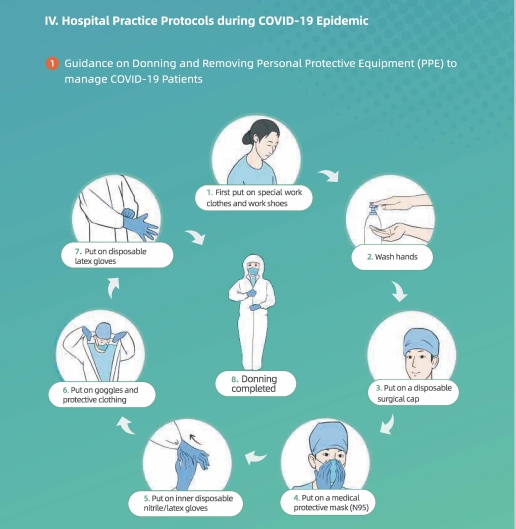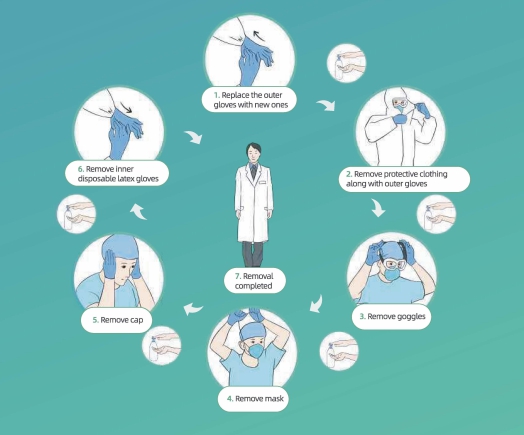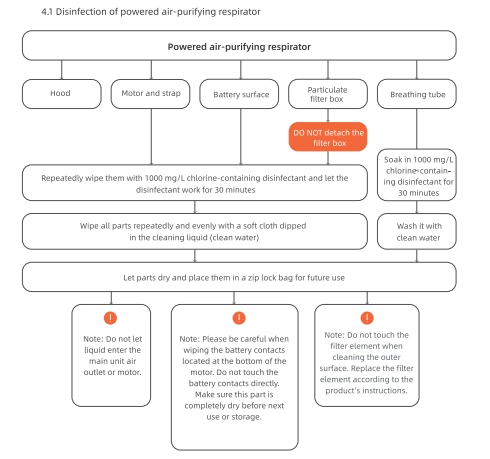
Protocol for Donning !'PE:
Put on special work clothes and work shoes • Wash hands~ Put on disposable surgical cal)~
Put on medical protective mask (N95) • Put on inner disposable nitrite/latex gloves • Put on
goggles and protective clothing (note: if wearing protective clothing without foot covers, please
also put on separate waterproof boot covers), put on a disposable isolation gown (if required in
the specific work zone) and face shield/powered air-purifying respirator(if required in tne
specific work zone) • flut on outer disposable latex gloves

Jlrotocol for Removing JlJlE:
Wash hands and remove visible bodily fluids/blood contaminants on the outer surfaces at both hands
• Wash hands replace outer gloves with new gloves • Remove powered air-purifying respirator m
self-priming filter-type full-face mask/mask (if used) • Wash hands • Remove disposable gowns
along with outer gloves (if used) • Wash hands and put on outer gloves • Enter Removal Area No. G)
• Wash hands and remove protective clothing along with outer gloves (for gloves and protective
clothing, turn inside out, while rolling them down) (note: if used, remove the waterproof boot covers
with clothing) • Wash hands • Enter Removal Area No. ~ • Wash hands and remove goggles •
Wash hands and remove mask • Wash hands and remove cap • Wash hands and remove innei
disposable latex gloves • Wash hands and leave Removal Area No.~ • Wasti hands, take a stiower,
put on clean clothes and enter the clean area
f) Disinfection Procedures for COVID-19 Isolation Ward Area
2.1 Disinfection for Floor and Walls
(1) Visible pollutants shall be completely removed before disinfection and handled in
accordance with disposal procedures of blood and bodily fluid spills;
(2) Disinfect the floor and walls with 1000 mg/L chlorine-containing disinfectant through
floor mopping, spraying or wiping;
(3) Make sure that disinfection is conducted for at least 30 minutes;
(4) Carry out disinfection three times a day and repeat the procedure at any time when there
is contamination.
2.2 Disinfection of Object Surfaces
(1) Visible pollutants should be completely removed before disinfection and handled in
accordance with disposal procedures of blood and bodily fluid spills;
(2) Wipe the surfaces of objects with 1000 mg/L chlorine-containing disinfectant or wipes
with effective chlorine; wait for 30 minutes and then rinse with clean water. Perform disinfec�
tion procedure three times a day (repeat at any time when contamination is suspected);
(3) Wipe cleaner regions first, then more contaminated regions: first wipe the object surfac�
es that are not frequently touched, and then wipe the object surfaces that are frequently
touched. (Once an object surface is wiped clean, replace the used wipe with a new one).
2.3 Air Disinfection
(1) Plasma air sterilizers can be used and continuously run for air disinfection in an environment with
human activity;
(2) If there is no plasma air sterilizers, use ultraviolet lamps for 1 hour each time. Perform this operation
three times a day.
2.4 Disposal of Fecal Matter and Sewage
(1) Before being discharged into the municipal drainage system, fecal matter and sewage
must be disinfected by treating with chlorine-containing disinfectant (for the initial
treatment, the active chlorine must be more than 40 mg/L). Make sure the disinfection time
is at least 1.5 hours;
(2) The concentration of total residual chlorine in the disinfected sewage should reach 1 O
mg/L.
E) Disposal Procedures for Spills of COVID-19 Patient Blood/Fluids
3.1 For spills of a small volume(< 10 ml) of blood/bodily fluids:
(1) Option 1: The spills should be covered with chlorine-containing disinfecting wipes (con�
taining 5000 mg/L effective chlorine) and carefully removed, then the surfaces of the object
should be wiped twice with chlorine-containing disinfecting wipes (containing 500 mg/L
effective chlorine);
(2) Option 2: Carefully remove the spills with disposable absorbent materials such as gauze,
wipes, etc., which have been soaked in 5000 mg/L chlorine-containing disinfecting solution.
3.2 For spills of a large volume(> 1 O ml) of blood and bodily fluids:
(1) First, place signs to indicate the presence of a spill;
(2) Perform disposal procedures according to Option 1 or 2 described below:
(j) Option 1: Absorb the spilled fluids for 30 minutes with a clean absorbent towel (containing
peroxyacetic acid that can absorb up to 1 L of liquid per towel) and then clean the contami�
nated area after removing the pollutants.
al Option 2: Completely cover the spill with disinfectant powder or bleach powder contain�
ing water-absorbing ingredients or completely cover it with disposable water-absorbing
materials and then pour a sufficient amount of 10,000 mg/L chlorine-containing disinfectant
onto the water-absorbing material (or cover with a dry towel which will be subjected to
high-level disinfection). Leave for at least 30 minutes before carefully removing the spill.
(3) Fecal matter, secretions, vomit, etc. from patients shall be collected into special contain�
ers and disinfected for 2 hours by a 20,000 mg/L chlorine-containing disinfectant at a
spill-to-disinfectant ratio of 1 :2.
(4) After removing the spills, disinfect the surfaces of the polluted environment or objects.
(5) The containers that hold the contaminants can be soaked and disinfected with 5,000
mg/L active chlorine-containing disinfectant for 30 minutes and then cleaned.
(6) The collected pollutants should be disposed of as medical waste.
(7) The used items should be put into double-layer medical waste bags and disposed of as
medical waste.
Disinfection of COVID-19 Related Reusable Medical Devices

Note: The disinfection procedures for protective hood described above are only for reusable protec�
tive hoods (excluding disposable protective hoods).
4.2 Cleaning and Disinfection Procedures for Digestive Endoscopy and Bronchofibro�
scopy
(1) Soak the endoscope and reusable valves in 0.23% peroxyacetic acid (confirm the
concentration of the disinfectant before use to make sure it will be effective);
(2) Connect the perfusion line of each channel of the endoscope, inject 0.23% pero�
xyacetic acid liquid into the line with a 50 ml syringe until fully filled, and wait for 5
minutes;
(3) Detach the perfusion line and wash each cavity and valve of the endoscope with a
disposable special cleaning brush;
(4) Put the valves into an ultrasonic oscillator containing enzyme to oscillate it.
Connect the perfusion line of each channel with the endoscope. Inject 0.23% pero�
xyacetic acid into the line with a 50 ml syringe and flush the line continuously for 5
minutes. Inject air to dry it for 1 minute;
(5) Inject clean water into the line with a 50 ml syringe and flush the line continuously
for 3 minutes. Inject air to dry it for 1 minute;
(6) Perform a leakage test on the endoscope;
(7) Put in an automatic endoscopic washing and disinfection machine. Set a high level
of disinfection for treatment;
(8) Send the devices to the disinfection supply center to undergo sterilization with
ethylene oxide.
4.3 Pre-treatment of Other Reusable Medical Devices
(1) If there are no visible pollutants, soak the device in 1 ooo mg/l chlorine-containing
disinfectant for at least 30 minutes;
(2) If there are any visible pollutants, soak the device in 5000 mg/l chlorine-containing
disinfectant for at least 30 minutes;
(3) After drying, pack and fully enclose the devices and send them to the disinfection
supply center.



